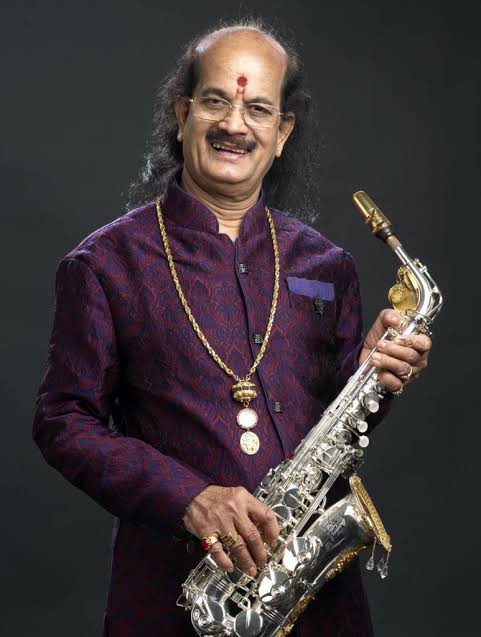 When many core volunteers called me last night, they all shocked me with the tragic news that the Saxophone King, Kalaimamani, Padmasri Kadri Gopalnath passed away at Mangalore.
When many core volunteers called me last night, they all shocked me with the tragic news that the Saxophone King, Kalaimamani, Padmasri Kadri Gopalnath passed away at Mangalore.
One of the most creative Carnatic instrumentalist from Karnataka has left us permanently.
Being kriti based, the survival of instrumental soloists in Carnatic music has been a major issue. Nadaswaram was one true exception to this rule. Prior to the advent of microphones, it reached wider audience with no real need for additional audio enhancement. A galaxy of Nadaswara vidwans with Tavil vidhwans across the South Indian states had a successful career, till mid-twentieth century. They were given guaranteed support at all major temple festivals across the length and breadth of South Indian states. After the advent of concert platforms with mike-enhanced music and after the emergence of Movie talkies across small towns giving new entertainment to the common man, Nadaswaram music languished for public support. Its survival in marriages is more for religious sanctity than for musical quality.
Western violin has been the very first instrument that found acceptance as the accompanying instrument. Even the legendary violin maestros like Lalgudi Jayaraman and M.S. Gopalakrishnan became total soloists only after long and arduous battle as accompanying artists for many creative — as well as for — not so creative vocalists. Many vocalists were no match for their musical depths.
The center of Carnatic music is in the development of major kritis, with a preamble in raga alapana. Except for violin, none of the other instruments — Indian or Western — seem to have the capability of giving support to vocalists. Any one choosing any melodic instrument ( not a percussion instrument ) has to struggle to survive as soloists, till they can be established. Until you are an instrumental genius with a feel for kritis, you have very little chance to survive as instrumental soloists.
Mali was the first such genius flutist who survived as a soloist with pomp and glory. It was not the same with Vainikas who needed mike support. They relied on tanam and other instrumental techniques to carry them through. Their concerts survived on the latter half of concert with lighter vein.
After violin, we were exposed to Clarinet, the next novel western instrument. It could neither replace Nadaswaram nor had the ability to survive on concert platforms.
At the tender age of seven the Mandolin prodigy Srinivas from Andhra simply swept the whole Carnatic music platform by his creativity and dexterity in handling the little doll like instrument — Mandolin. Even the greatest of music critics saw the value for this instrument thanks to the melodic outpourings of Srinivas.
Hailing from a well established Nadaswaram family of Karnataka, Kadri Gopalnath was drawn to the Western instrument, Saxophone, for its soothing base output. He decided to take the major risk in adopting Saxophone for the Carnatic Music platform. With no local support from Karnataka, Kadri’s challenges were tremendous, but he will not cave in.
His first performance in CTU in 1987 with the kriti, Abeeshta varada in Hamsadhwani, took every music lover by surprise. The instrument was novel, the music was soothing, kritis played were very melodic, the dexterity of his handling the instrument was unquestionable. After the initial period he was able to successfully team up with Ms Kanyakumari on violin and their cooperative musical output reached great heights and was noticed by many music lovers across the world and it gave a major thrust for instrumental solo performances. Like Madurai Mani Iyer, he was quite generous to share the concert platforms with lot of thani avartanam opportunities for percussionists like Harikumar, Nakode and others.
Kadri shot to tremendous popularity when music director A.R. Rahman introduced Kadri’s saxophone music to common audience through the very popular movie- Duet. The support of common man is essential for one’s musical professional rise through increased audience. Almost all great professional musicians have succeeded by a small entry to light music. That is true with Smt. M.S. Subbulakshmi (Katrinile varum Geetam), Smt. M.L. Vasanthakumari ( Ellaam Inbamayam), Sri Balamurali Krishna ( Oru Nal poduma), Smt. Nithyashree ( Kannodu Kanbadellaam) , Bombay Jayashri ( Narumugaiye). This list is endless.
Kadri’s important contribution to music lovers in USA is his willingness to train some of the talented USA based students by a proper gurukulam training. CTU owes a lot to Sri Kadri Gopalnath for his musical generosity for imparting his knowledge to deserving students. Often musicians hesitate to give away their knowledge to anyone outside their immediate family.
During the annual CTU Cart procession of Saint Tyagaraja on the second day of the Chicago Tyagaraja Utsavam during the Memorial Day weekend, it is his students who pour their heart and soul to the procession by playing on Saxophone, the kritis they have learnt from him. Where we have no Nadaswaram music, we have Saxophone music. It has become the standard practice even in marriage pandals and temple festivals. It is tacitly accepted as a mangala vadhyam.
It is all only due to Sri Kadri Gopalnath and this phenomenal contribution will be eternally appreciated by all Carnatic music lovers.
In grief,
Dr. T.E.S. Raghavan

